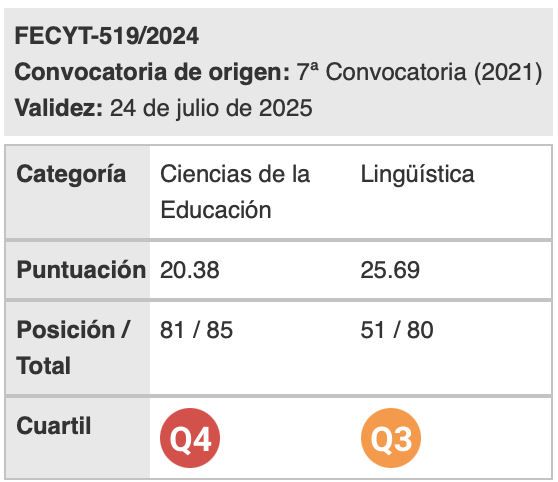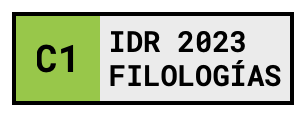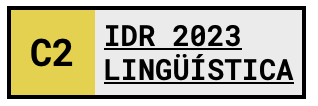The use of subtitled TV series as a didactic resource for the EFL class in higher education
Palabras clave:
Inglés como lengua extranjera, u-learning, series de TV, subtítulos, escucha, habla, vocabularioResumen
Los modelos de enseñanza de idiomas están en constante cambio. De aprender basado en un sistema de actividades repetitivas y orientadas a la gramática en el aula, hemos pasado al aprendizaje ubicuo (u-learning), donde los recursos y herramientas utilizados ganan importancia en comparación con elementos como el tiempo y el espacio. En este escenario, las series de televisión con subtítulos integrados aparecen como un recurso para mejorar las habilidades de escucha, habla y vocabulario entre los estudiantes españoles de inglés como segundo idioma (ESL). El objetivo principal de este artículo es presentar un estudio de caso que incluye ver series de televisión como una actividad continua fuera del aula para motivar a los estudiantes universitarios a lograr una mejora real en las habilidades de escucha, habla y vocabulario. Esto brinda un impulso adicional a las competencias lingüísticas de los estudiantes e introduce un factor de motivación adicional para que continúen utilizando el inglés fuera del entorno académico.
Descargas
Citas
Al-Biruni, A. R. (1910). Chapter XVI: Notes on the Writing of the Hindus, on their Arithmetic and Related Subjects, and on Certain Strange Manners and Customs of theirs. In E. C. Sachau (Ed.), Alberuni’s India: An Account of the Religion, Philosophy, Literature, Geography, Chronology, Astronomy, Customs, Laws and Astrology of India about AD 1030 (pp. 170–186). K. Paul, Trench, Trübner & Co., ltd.
Álvarez Gil, F. J. (2022). Análisis de textos audiovisuales para la enseñanza de contenidos históricos en la especialidad de Filología Inglesa. En Felipe Morales, A.; Cremades García, R.; Villanueva Roa, J. Comunicando en el siglo XXI: Avances metodológicos y nuevas estrategias, 86-96. Tirant lo Blanch.
Álvarez-Gil, F. J., & Alonso-Almeida, F. (2017). El cine como herramienta didáctica para la inclusión del elemento cultural en la clase de inglés como lengua extranjera. Revista Educação e Linguagens, 6(11), 44–62.
Araújo Vila, N., Fraiz Brea, J. A., & Cardoso, L. (2019). The influence of sociodemographic variables on audiovisual consumption: The case of Spain. Social Sciences, 8(8), 1–17.
Azaryad Shechter, D. (2018). Overcoming the Grammar Barrier in Foreign Language Learning: The Role of Television Series. Journal of Language and Education, 4(2), 59–72. https://doi.org/10.17323/2411-7390-2018-4-2-59-72
Bailey, K. M. (2003). Speaking. In D. Nunan (Ed.), Practical English Language Teaching (pp. 47–66). McGraw-Hill/Contemporary.
Boronat, F., Montagud, M., Marfil, D., & Luzon, C. (2018). Hybrid Broadcast/Broadband TV Services and Media Synchronization: Demands, Preferences and Expectations of Spanish Consumers. IEEE Transactions on Broadcasting, 64(1), 52–69.
Castro, D., & Cascajosa, C. (2020). From Netflix to Movistar+: How Subscription Video-on-Demand Services Have Transformed Spanish TV Production. JCMS: Journal of Cinema and Media Studies, 59(3), 154–160.
Cenoz, J., & Lecumberri, M. L. G. (1999). The acquisition of English pronunciation: learners’ views. International Journal of Applied Linguistics, 9(1), 3–15.
Criado, R., & Sánchez Pérez, A. (2009). English Language Teaching in Spain: Do Textbooks Comply with the Official Methodological Regulations? A Sample Analysis. IJES, International Journal of English Studies, 9(1), 1–28.
Crystal, D. (2006). English Worldwide. In R. Hogg & D. Denison (Eds.), A History of the English Language (pp. 420–439). Cambridge University Press.
Crystal, D. (2014). Why English? The historical context. In English as a global language (pp. 29–71). Cambridge University Press.
De Wilde, V., Brysbaert, M., & Eyckmans, J. (2020). Learning English through out-of-school exposure. Which levels of language proficiency are attained and which types of input are important? Bilingualism: Language and Cognition, 23(1), 171–185.
Dörnyei, Z., & Dewaele, J.-M. (2022). Constructing the Questionnaire. In Questionnaires in Second Language Research: Construction, Administration, and Processing (pp. 14–60). Routledge.
European Commission, Directorate-General for Education, Youth, S. and C. (2017). ECTS users’ guide 2015 (pp. 1–108). Publications Office.
Frumuselu, A. D., De Maeyer, S., Donche, V., & Colon Plana, M. del M. G. (2015). Television series inside the EFL classroom: Bridging the gap between teaching and learning informal language through subtitles. Linguistics and Education, 32, 107–117.
Gómez-Calderón, M. J. (2021). EMI and the Teaching of Cultural Studies in Higher Education: A Study Case. Language Value, 14(2), 87–113.
Herrero Subías, M., Medina Laverón, M., & Urgellés Molina, A. M. (2018). Online recommendation systems in the spanish audiovisual market: Comparative analysis between atresmedia, movistar+ and netflix. UCJC Business and Society Review, 15(4), 54–89.
Hoyos, J. A. (2018). A Guide for Cooperative Teachers to Enhance Vocabulary Acquisition Through The Use of Animated Television Series in the Fourth Grade at a Primary School. Entornos, 31(2), 18–27.
Informe Barlovento: las series de EE.UU. en TV. (2017). Barlovento Comunicación. https://www.barloventocomunicacion.es/informes-barlovento/series-de-eeuu-en-tv/
Instituto Nacional de Tecnologías Educativas y Formación del Profesorado (INTEF). (2017). Marco Común de la Competencia Digital Docente (Octubre 2017).
Jiahong, Y., Liberman, M., & Cieri, C. (2006). Towards an integrated understanding of speaking rate in conversation. Proceedings of the Annual Conference of the International Speech Communication Association, INTERSPEECH, 2, 541–544.
Liu, C. H. (2010). The comparison of learning effectiveness between traditional face-to-face learning and e-learning among goal-oriented users. Proceeding - 6th International Conference on Digital Content, Multimedia Technology and Its Applications, IDC2010, 255–260.
Maniati, R. G. (2020). Television series in the EFL classroom: The one with “Friends” as a teaching resource material. Aristotle University of Thessaloniki.
Martín-Quevedo, J., Fernández-Gómez, E., & Segado-Boj, F. (2019). How to Engage with Younger Users on Instagram: A Comparative Analysis of HBO and Netflix in the Spanish and US Markets. International Journal on Media Management, 21(2), 67–87.
Molenda, M. (2008). Historical Foundations. In J. M. Spector, M. D. Merrill, J. van Merriënboer, & M. P. Driscoll (Eds.), Handbook of Research on Educational Communications and Technology (pp. 3–20). Routledge.
Nielsen Ratings. (n.d.). Nielsen Media Research. Retrieved October 13, 2020, from https://www.nielsen.com/es/es/
Ortega Barrera, I. (2019). Uso del podcast como recurso didáctico para la mejora de la comprensión auditiva del inglés como segunda lengua (L2). Revista de Lenguas Para Fines Específicos, 25(2), 9–25.
Reichelt, M. (2006). English in a Multilingual Spain. English Today, 22(3), 3–9.
Robinson, R., Molenda, M., & Rezabek, L. (2008). Facilitating Learning. In A. Januszewski & M. Molenda (Eds.), Educational Technology: A Definition with Commentary (pp. 15–48). Routledge.
Rupérez Micola, A., Bris, A., & Banal-Estañol, A. (2009). TV or Not TV? Subtitles and English Skills. SSRN Electronic Journal, 1–27.
Sadiku, L. M. (2015). The Importance of Four Skills Reading, Speaking, Writing, Listening in a Lesson Hour. European Journal of Language and Literature, 1(1), 29–31.
Scheffler, P., Jones, C., & Domińska, A. (2020). The Peppa Pig television series as input in pre-primary EFL instruction: A corpus-based study. International Journal of Applied Linguistics (United Kingdom), 1–15.
Tajgozari, M. (2019). The effect of watching captioned TV series on speaking accuracy of Iranian advanced EFL learners. Global Journal of Foreign Language Teaching, 9(3), 157–166.
The European Parliament and the Council of the European Union. (2006). Recommendation of the European Parliament and of the Council of 18 December 2006 on key competences for lifelong learning. Official Journal of the European Union, 49, 10–19.
Uribe-Enciso, O. L., Fuentes Hernandez, S. S., Vargas Pita, K. L., & Rey Pabón, A. S. (2019). Problematic Phonemes for Spanish-speakers’ Learners of English. GIST – Education and Learning Research Journal, 19, 215–238.
Wan, G. (2000). Barney and Friends: An Evaluation of the Literacy Learning Environment Created by the TV Series for Children. ERIC - Education Resources Information Center, 1–21.
Yahya, S., Ahmad, E. A., & Abd Jalil, K. (2016). The definition and characteristics of ubiquitous learning: A discussion. International Journal of Education and Development Using Information and Communication Technology, 6(1), 117–127.
Zafra, I. (2019). España perpetúa el mal nivel de inglés mientras otros países mejoran. El País. https://elpais.com/sociedad/2019/11/01/actualidad/1572624274_785743.html
Descargas
Publicado
Cómo citar
Número
Sección
Licencia
Aquellos autores/as que tengan publicaciones con esta revista, aceptan los términos siguientes:
- Los autores/as conservarán sus derechos de autor y garantizarán a la revista el derecho de primera publicación de su obra, el cuál estará simultáneamente sujeto a la Licencia de reconocimiento de Creative Commons que permite a terceros compartir la obra siempre que se indique su autor y su primera publicación esta revista.
- Los autores/as podrán adoptar otros acuerdos de licencia no exclusiva de distribución de la versión de la obra publicada (p. ej.: depositarla en un archivo telemático institucional o publicarla en un volumen monográfico) siempre que se indique la publicación inicial en esta revista.
- Se permite y recomienda a los autores/as difundir su obra a través de Internet (p. ej.: en archivos telemáticos institucionales o en su página web) antes y durante el proceso de envío, lo cual puede producir intercambios interesantes y aumentar las citas de la obra publicada. (Véase El efecto del acceso abierto).

Revista de Lenguas para fines específicos is licensed under a Creative Commons Reconocimiento-NoComercial-SinObraDerivada 4.0 Internacional License.























